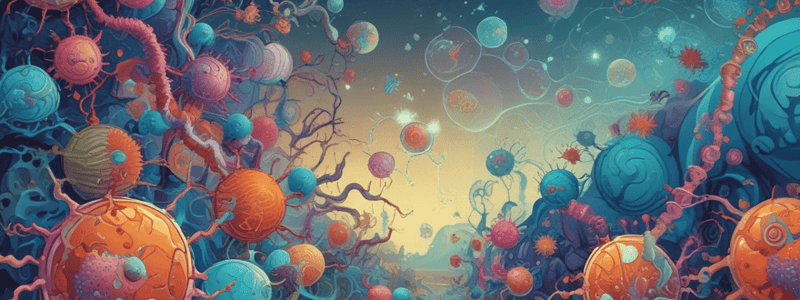Podcast
Questions and Answers
What is the function of the Hemagglutinin (HA) glycoprotein?
What is the function of the Hemagglutinin (HA) glycoprotein?
- To inhibit the M2 protein
- To release dopamine in the CNS
- To cause antigenic shift
- To bind to sialic acid in membranes of RBCs and Upper respiratory cells (correct)
What is the result of antigenic shift?
What is the result of antigenic shift?
- Changes in the hemagglutinin and neuraminidase molecules
- Epidemics and seasonal flu
- Segment changes and pandemics (correct)
- Point mutations in the viral genome
What is the function of the M2 protein?
What is the function of the M2 protein?
- To inhibit the Hemagglutinin
- To bind to sialic acid
- To change the pH to allow for uncoating (correct)
- To release dopamine in the CNS
What type of mutations occur in antigenic drift?
What type of mutations occur in antigenic drift?
What is the effect of Amantadine and Rimantadine?
What is the effect of Amantadine and Rimantadine?
What is the function of the neuraminidase (NA) molecule?
What is the function of the neuraminidase (NA) molecule?
What is the result of antigenic drift?
What is the result of antigenic drift?
What type of RNA virus is influenza?
What type of RNA virus is influenza?
Which of the following is NOT a type of influenza virus?
Which of the following is NOT a type of influenza virus?
What is the primary function of Neuraminidase in the life cycle of the influenza virus?
What is the primary function of Neuraminidase in the life cycle of the influenza virus?
What is the trade name for Oseltamivir, which is an NA inhibitor?
What is the trade name for Oseltamivir, which is an NA inhibitor?
How is influenza primarily spread?
How is influenza primarily spread?
What is the name of the protein associated with viral attachment to host cells?
What is the name of the protein associated with viral attachment to host cells?
What is the term for the minor variation in the HA and NA genes that occurs during RNA replication?
What is the term for the minor variation in the HA and NA genes that occurs during RNA replication?
What is the name of the syndrome characterized by ascending paralysis?
What is the name of the syndrome characterized by ascending paralysis?
What is the term for the reassortment of human strains with other circulating viruses in other species?
What is the term for the reassortment of human strains with other circulating viruses in other species?
What is the primary location of replication for RNA viruses, with the exception of Orthomyxovirus?
What is the primary location of replication for RNA viruses, with the exception of Orthomyxovirus?
What is the characteristic of viral RNA polymerases that contributes to the high mutation rate of Influenza A?
What is the characteristic of viral RNA polymerases that contributes to the high mutation rate of Influenza A?
What is the name of the syndrome associated with aspirin treatment of influenza in children?
What is the name of the syndrome associated with aspirin treatment of influenza in children?
Flashcards are hidden until you start studying
Study Notes
Influenza Virus Structure and Function
- Influenza virus is an RNA, negative-sense, single-stranded virus.
- It brings its own polymerase.
Replication
- Replication occurs in the nucleus.
Characteristics
- Enveloped virus.
- Influenza virus has 8 segments, allowing for 8 places to mutate.
Antigenic Shift and Drift
- Antigenic drift: point mutations in the viral genome leading to changes in hemagglutinin (HA) and neuraminidase (NA) molecules, causing seasonal flu and epidemics.
- Antigenic shift: reassortment of human strains with other circulating viruses in other species, causing pandemics and limited to Influenza A.
Influenza Virus Types
- There are three main influenza viruses: A, B, and C.
- Influenza A causes epidemics and pandemics due to antigenic shift.
- Influenza B causes epidemics due to antigenic drift.
Hemagglutinin (HA)
- Hemagglutinin (HA) is a glycoprotein that binds to sialic acid found in membranes in the upper respiratory tract and red blood cells, causing them to clump.
- HA defines cell tropism (cells that can be affected).
- HA molecule binds to sialic acid on the cell membrane, then is endocytosed into the cell, where the pH needs to be changed by M2 protein to allow for uncoating.
M2 Protein
- M2 protein changes the pH, allowing for uncoating.
- M2 protein is inhibited by Amantadine and Rimantadine.
Neuraminidase (NA)
- Neuraminidase (NA) allows the virus to break free from sialic acid inside the host cell.
- NA is inhibited by Oseltamivir (Tamiflu) and Anamivir.
Viral Transmission and Prevention
- Influenza virus is spread by respiratory droplets.
- Killed virus is used for intramuscular (IM) vaccination.
- Live vaccine is also available.
Complications
- Staphylococcus aureus pneumonia can occur as a complication.
- Reyes syndrome, associated with aspirin treatment, can cause encephalitis and hepatomegaly.
- Guillain-Barré syndrome, a rare complication, causes ascending paralysis.
Key Proteins
- M1: Matrix protein.
- M2: ion channel.
- NA: neuraminidase.
- HA: Hemagglutinin (viral attachment protein).
Studying That Suits You
Use AI to generate personalized quizzes and flashcards to suit your learning preferences.




